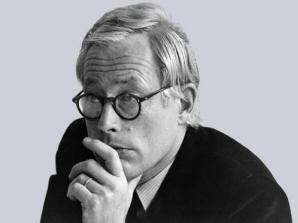|
A further innovation follows in 1932: Max Braun expands
his product range and ranks among the first European
manufacturers to incorporate the radio and record player
in one set. |
 |
|
1935 marks the birth of the Braun brand. The company
logo already takes on its familiar form with the raised
letter "A". For his pioneering work Braun receives the
award "For special achievements in phonography" at the
1937 World’s Fair in Paris. In 1938, 1,000 people are on
the Braun payroll. |
|
|
In 1947, Braun gradually resumes production of its core
products: Radios and the "Manulux" pocket flashlight
begin to flow from the plant. |
|
In 1950 Braun begins series production of the first
electric shaver, the "S 50". This product incorporates
the successful combination of an oscillating cutter
block with an ultra-thin yet stable steel-foil mounted
above it. The principle of foil and cutterblock – in
further refined form – is still employed in today’s
Braun shavers. |
|
Max Braun dies in 1951. His sons Artur Braun (26) and
Erwin Braun (30) take over management. They carry on
their father’s lifework and take advantage of new
opportunities. |
|
In 1952, Braun enters the field of modern electronic
photo technology. First product is the "Hobby" portable
electronic flash unit, soon becoming standard equipment
of photo reporters worldwide. |
|
Prof. Wilhelm Wagenfeld and the Ulm Hochschule für
Gestaltung (Design Academy) in
1954 receive initial orders from the Braun brothers to
redesign the radios and phonographs. Their "honest
understated and functional design" is to set them apart
from the rest of the market. The most prominent advocate
of the new design is Dr Fritz Eichler. |
|
Attracting national and international attention, Braun
shows its entire radio line, redesigned in only eight
months, at the 1955 Dusseldorf Radio Exhibition. "Braun
Design" is born. |
|
In 1956 the Design Department commences work under Dr
Fritz Eichler. Together with colleagues, Dieter Rams –
initially hired as an architect – designs the Phonosuper
SK4, nicknamed "Snow White’s Coffin". Braun receives
major international awards for its design achievements.
The Museum of Modern Art, New York, expands its
collection to include many Braun units as models of
exemplary design. |

|
|
In 1959 Braun presents new appliances featuring
exceptionally innovative technology and design, among
others the first true Hi Fi system consisting of
individual components, the "Studio 2", making Braun the
leading German manufacturer in this area. |
|
With the "Mayadent" electric toothbrush, Braun in 1963
begins the Oral Care line, which is systematically
expanded in the Seventies. |
|
On 19 December 1967, The Gillette Company, Boston,
acquires a majority holding in Braun, providing the
company with financial and human resources to develop
into a truly intentional enterprise. |
|
The "Braun Prize for Technical Design", initiated by
Erwin Braun in 1967, is awarded to young designers for
the first time in 1968, remaining a regular event until
today. |
|
In 1977 Braun shows a radio-controlled clock as a highly
acclaimed innovative study at the Domotechnica trade
fair in Cologne. |
|
By 1981 Braun has become a leading manufacturer of small
electrical appliances. Sustained growth calls for
concentration of resources. The highly specialized photo
sector is taken over by Robert Bosch GmbH; additionally,
the Hi Fi sector is separated from Braun AG and
transformed into an independent company. |
|
In 1983 Braun receives the "Corporate Design Award"
conferred for the first time by the "Gute Industrieform"
council of the Hanover industrial fair. This prize
awarded for an "exemplary fully-integrated concept
encompassing product design, information and
presentation". |
|
In 1988 the 100 millionth Braun shaver runs off
production lines at the Walldurn plant. |
|
In 1991 Braun launched the world’s first electric
toothbrush with a round cup-shaped brush head and
innovative oscillating movement. This innovation has
become the most successful electric toothbrush worldwide
and one of the core product categories in the Gilette
portfolio. In the following year, Braun starts to
dramatically invest in sales and marketing organizations
in Eastern Europe and the Far East. Sales surpass 2
billion DM for the first time. The company celebrates 40
years of successful Braun Design in 1995. |
|
Bernhard Wild, head of the Technology and Business
Managements sectors, is appointed Chairman of the Board
in 1998. Blood pressure monitors are added to the new
personal diagnostic appliances product group. Also in
1998, Braun AG is converted into a GmbH, and one year
later all Gillette brands are consolidated in a joint
Gillette sales organization |
|
Braun becomes the technological centre within The
Gillette Company and assumes additionally RD
responsibility for Oral-B manual oral care products.
|